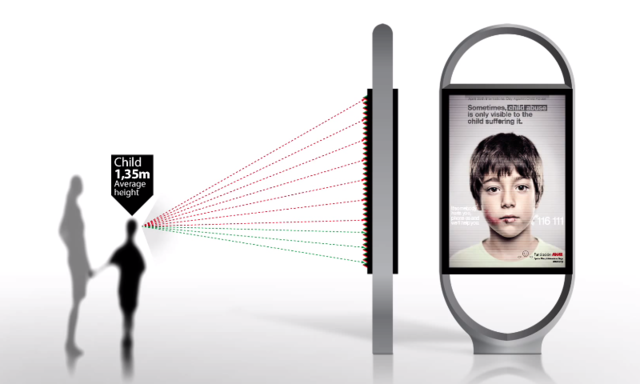
I recently saw an ad with an interesting technological approach, which would be used ostensibly to communicate to a particular group of people.
Hey ShesAllWrite, let’s suss this ad!
Michael:
This ad is pretty damned cool, at least from a technological perspective. It’s like those pictures of Jesus that follow you. I love those pictures! As a kid, I had some cool, postage-sized pictures of Bruce Banner and Peter Parker that turned into The Hulk and Spider-Man, respectively, depending on how you looked at them.
However, I think the ad is a far more effective campaign as self-promotion for the company that created the ad (“Look at this cool ad we made!”), and less a help for any kids in need.
Is the rationale of the ad that a kid is going to be accompanied by his abuser, and that while the abuser sees one thing, the kid sees something different that speaks directly to him? CALL FOR HELP, KID! IT’S OKAY! YOUR DAD CAN’T SEE THIS! UNLESS YOUR DAD IS VERY, VERY SHORT!
Is the rationale of the ad that the abuser would avoid the ad if it had a phone number to call, but without the number the abuser has no issue with walking by an ad that specifically talks about child abuse? Wouldn’t the abuser potentially avoid that ad as well?
Why not do this — why not have an ad geared toward adults that has nothing to do with child abuse? Have it be an ad for a vacation resort getaway that doesn’t exist. Then only the kids will see the real ad, and that ad will be about child abuse.
I think the use of technology in this ad campaign is actually a little creepy. This is yet another form of advertising that targets children. Advertisers already resort to countless scummy ways to separate kids from their parents. They actively try to turn kids into aggressive consumers who will harangue their parents to buy them things.
And with this ad, we see another potential, insidious mechanism for advertisers to specifically target kids.
Maybe, maybe this particular instance of advertising is for a noble (yet ineffective) purpose, but I see this technology quickly repurposed for shoes/videogames/movies/clothes/whatever, as another means of turning their kids against their parents, with familial feelings to be replaced by brand loyalty and a bottomless desire for material things.
BOOOOOOOOO!
Carla:
At first glance, I thought this ad campaign was genius. I still think it’s genius, but some of the warm fuzzies have worn off.
Let’s start with why I love the campaign. I love it because it presents a simple solution to a complex problem: How to talk to two people at the same time, and effectively deliver a different call to action to each. Brilliant! Well done! Applause!
*needle scratches across record*
WAITAMINUTE! What happens when brands use similar technology? They can now say something to my kid that I can’t see. They can have a conversation (albeit one-way) with my kid that I am not a part of. And they can sweet-talk ME while they’re doing it. Oh, hell no!
This mechanism wouldn’t work very well for products geared only toward children because the campaign needs parallel messaging in order to work its magic, but think of these sinister (but no less genius) applications–campaigns for Disneyland Resort vacations, fast food or minivans. Talk to Mom and Dad about all-inclusive deals, mealtime convenience and vehicle functionality; talk to kids about Mickey Mouse, kids’ meal toys and rear-seat DVD players. Parents would no longer be making decisions about grown-up purchases by themselves–they’d have the kiddo contingent to contend with. In the wrong hands, this super power could be used for evil. It could also be used for good in other PSA campaigns–healthy eating, anti-smoking, anti-drug, and so on. I’d like to think we could trust advertisers not to exploit our relationships with our children for financial gain, but I know better.
I did want to touch on Michael’s comment about the effectiveness of the specific campaign in question. I know a little bit about abuser-abusee relationships and I think I can speak on why this would be effective. Being confronted with, or threatened with being outed or punished for his behavior causes an abuser to become very insecure and hostile. The hostility is almost always absorbed by the person he is abusing. By giving the adults a benign and fairly non-confrontational ‘stop-and-think’ message, the campaign avoids creating conflict between the abuser and his victim. The message that is displayed to the child would almost surely enrage the abuser and plant seeds for future conflict between the abuser and his victim. Domestic violence PSA campaigns have always had to tiptoe around this issue.
I also wanted to mention that I agree this campaign is a great publicity-generator for Grey Group–the agency that created it.
I can’t quite give it a boo, so I give it a cautious yay.